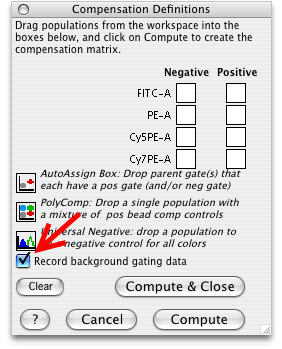

To accurately distinguish between two distinct fluorophore signals, researchers must process their data to compensate.

When multiple fluorophores are used, the signals begin to overlap. Spillover occurs because each tag, called a fluorophore, emits light within a range of wavelengths, giving it a unique colour. Using multiple fluorescent signals raises a key issue in flow cytometry called spillover. It is very gratifying to see computational biology have a direct and real impact on research and diagnostics." The collaboration with FlowJo has enabled us to instantly reach 80,000 users. Our new approach reduces error by 100,000-fold, making research and diagnostics more accurate. Despite the technical progress over the past decades, the technology has been held back by the mathematical processing of the data. Adrian Liston, explained: "Flow cytometry is a foundational technology across many different biomedical research areas, and is a key diagnostic tool in immunology, haematology and oncology. Immunology programme senior group leader Prof. The new technique is published in Nature Communications today. AutoSpill, an algorithm developed by researchers at the Babraham Institute and the VIB Center for Brain Research, brings data processing in line with state-of-the-art machines, simplifying data analysis and increasing accuracy. However, while flow cytometry equipment has been updated, the accompanying computational requirements have received less attention, until now. Advances in flow cytometry have allowed scientists to gather data on a growing number of parameters, simultaneously detecting over 30 different tags at a time to allow more sophisticated analyses and much deeper levels of insight. As with personal gadgets and devices, innovation in molecular biology technologies isn’t standing still. Cell identification is achieved by labelling cells with fluorescent tags.
#Compensation in flowjo software#
Researchers can use the tool, available online and through the software package FlowJo, to easily reduce compensation errors in their flow cytometry data.įlow cytometry is a key investigative tool used in biomedical research, allowing researchers to identify, separate and study cells according to their characteristics, often working with cell samples containing millions of cells at an analysis pace of a million cells per minute.The tool, called AutoSpill, addresses the problem of overlapping signals and autofluoresence, which can be misinterpreted as genuine results.
#Compensation in flowjo full#
A new algorithm developed by researchers at the Babraham Institute provides a fast and effective way to reduce errors in flow cytometry data analysis, overcoming a major restriction on harnessing the full potential of the power of flow cytometry in cell analysis.Go with the flow – a new algorithm streamlines and improves flow cytometry analysis


 0 kommentar(er)
0 kommentar(er)
